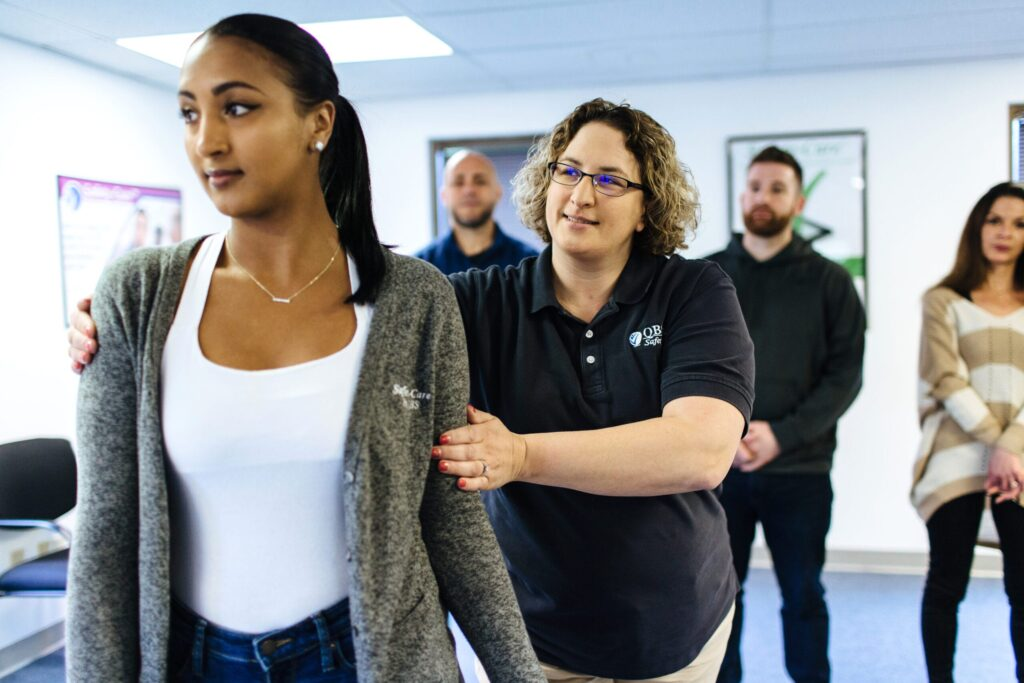California Department of Education – Behavioral Interventions, Chapter 5.5, 56520-56525
The State of California adopted Chapter 5.5, 56520-56525 for the purpose of defining the use of behavioral interventions in schools. Safety-Care can be a vital part of ensuring that staff are best equipped to meet these requirements. Below is a summary of the regulation, along with descriptions of how Safety-Care can be utilized.
.jpg)
.png?width=88&height=95&name=Group%20137%20(5).png)


How to Implement Safety-Care?
1. Register for a Safety-Care Trainer class or call us to request a closed session for your organization. We regularly conduct classes in all 50 states and Canada.
2. Complete your class to become a certified Safety-Care Trainer for your organization. We bring you to fluency using an errorless teaching methodology.
3. You train and certify your staff in Safety-Care’s effective techniques.
4. Our Master Trainers are available by phone, email, or video to help your organization with any questions or concerns while using or implementing Safety-Care.

Legal Requirements
|
Summary: Last Amended Date: 07-01-2013 Last Updated: December, 2024 The State of California adopted Chapter 5.5, 56520-56525 for the purpose of defining the use of behavioral interventions in schools. Safety-Care can be a vital part of ensuring that staff are best equipped to meet these requirements. Below is a summary of the regulation, along with descriptions of how Safety-Care can be utilized. Chapter 5.5 on Behavioral interventions is broken down into significant sections that address specific needs. These sections relate the following: |
|
56520 - Legislative Findings and Intent:
How Safety-Care aligns: Safety-Care focuses on the use of Incident Prevention prior to the use of any physical intervention. All personnel are trained to treat the persons under their care in a humane and professional manner. Our program emphasizes de-escalation as a primary strategy before the use of physical interventions. If physical interventions are needed, Safety-Care ensures that the practices that are trained and used are as safe and appropriate as possible to both staff and student. |
|
56521 - Scope and Monitoring: |
56521.1 - Emergency Interventions:
|
|
56521.2 - Prohibited Interventions:
|
|
56523 - Regulations Repeal and Compliance: This section repeals outdated regulations and emphasizes compliance with federal laws and states that local educational agencies must adhere to these regulations as a condition for receiving federal funding. Additionally it empowers the Superintendent to monitor and enforce compliance, with potential fiscal repercussions for noncompliance. |
|
56524 - Teacher Training Requirements: Directs the Superintendent to collaborate with higher education institutions and the Commission on Teacher Credentialing to ensure adequate training in behavioral interventions for educators. |
|
56525 - Behavior Analyst Certification: The final section recognizes Board Certified Behavior Analysts as qualified to conduct behavior assessments and provide intervention services for exceptional needs individuals but does not mandate the use of such certified analysts. How Safety-Care aligns: All Master Trainers that conduct initial Safety-Care trainings are Board Certified Behavior Analysts. These experts are also available to assist with questions and concerns both during and after the initial training. |
|
These regulations aim to ensure the safe and effective use of behavioral interventions while upholding the rights and dignity of individuals with exceptional needs in educational settings. How Safety-Care aligns: Safety-Care provides quality behavioral solutions to complex behavior challenges through evidence-based training and consulting. Safety-Care is designed for educators and staff working with individuals with exceptional needs in both public and nonpublic school programs. |
Why Safety-Care?
Benefits & Differentiators
In addition to Safety-Care being highly cost-effective, you get:

Skills to effectively prevent, minimize, & manage behavioral challenges with dignity, safety, & the possibility of change

Decreases in staff and patient injuries and reduction in restraint & seclusion time

Instructional procedures based on decades of evidence-based research & compatible with ABA, PBIS & reinforcement-based environments

Customizable program for your setting, staff & clientele, with a strong focus on preventative via non-intrusive, replacement behaviors

Extremely rigorous standards grounded in errorless teaching methodology

Small, intimate class sizes backed by unlimited support & resources
How Is Safety-Care So Effective?
A Genuine Focus on Implementing & Managing Positive Behavioral Skills
Proactive, environmental management recommendations
Understanding of evocative effects of staff behavior
In-depth analysis of antecedents and proactive antecedent interventions
Evidence-based reinforcement procedures
Required competency in de-escalation skills
Humane, non-invasive touch and QBS Check™ strategies
Evidence-based teaching procedures
Applicable to a wide array of settings, conditions & challenging behavior





